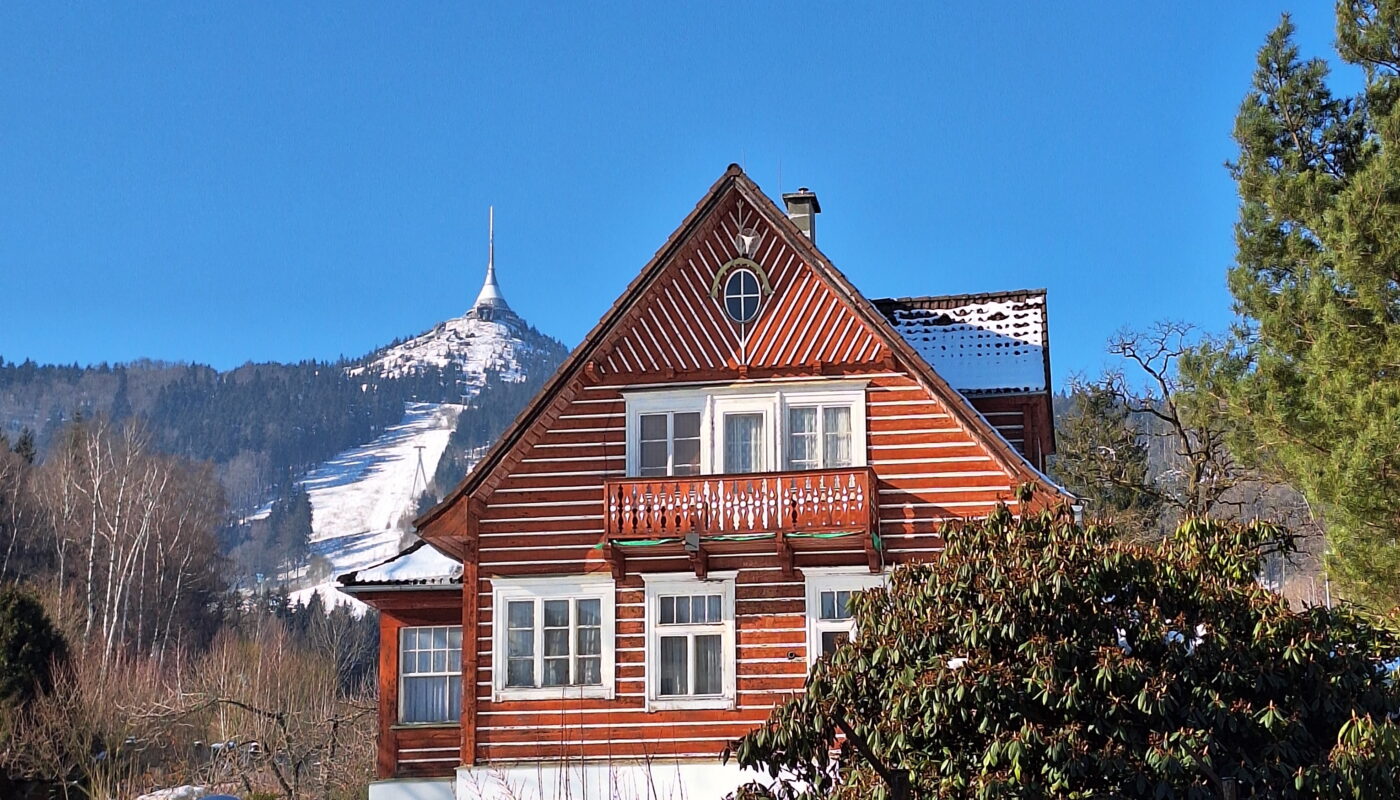Reading Time: 7 Minutes 13 Seconds
Historical context
By the mid 19th century, a wooden cabin was already situated at the top of Ještěd mountain.
Between 1863 and 1867, a road was built from Horní Hanychov to Křižany crossing the Tetřeví pass, to allow easier access.
As interest in the mountain peak grew, at the beginning of the 20th century a new and bigger building was erected in place of the hut to accommodate visitors and hikers. The building also served as television broadcasting station starting from 1959.
Primarily made of wood, this structure was destroyed after several fires.
After the last burnt down in 1963, an architectural competition was launched for the creation of a complex consisting of a mountain hotel with a restaurant, and a television signal antenna.
Eleven teams of architects participated in the competition and the jury selected the project of architect Karel Hubáček and structural engineer Zdeněk Patrman.
Instead of having two separate objects – a hotel with a restaurant and a television transmitter – Hubáček’s design included only a single building that combined both functions.
In addition, the shape he chose was something never used before in architecture, a rotating hyperboloid.
The official ceremony for laying the foundation stone took place on the 30th of July 1966, but the construction of the building and its interiors did not complete until 1973.
On the 1st of May 1971 , the antenna transmitted the first television signal, and the official opening of the entire building took place in the summer of 1973.
The hotel encountered issues shortly after its completion due to strong air currents causing dangerous vibrations in the upper part of the building.
The problem was resolved by adding a 600 kg weight to the structure’s axis and installing vibration dampers.
In January 2006, the building was declared a national cultural monument.
Architectural details of Ještěd
The structure
The foundation of the building consists of a circular reinforced concrete slab with a thickness of 1m and a diameter of almost 14m.
This area is today the basement, that hosts the engine rooms for all the energy equipment and a storage area.
The building’s support system consists of two concentric reinforced concrete columns positioned at the center. The columns are also functional, as they contain staircases and elevators.
The floors are constructed using suspended steel frameworks that are anchored to the central concrete columns.
The most difficult task was the technical side of the new structure, as all the antennas that usually stick out on other transmitters were placed inside the building, so a special laminate shell had to be developed.
The exteriors
The building perfectly follows the natural slopes of Ještěd, visually enhancing its height by 94m and giving the impression that it is truly integrated with the mountain.
The exterior features a conical shape, clad in anodized aluminum panels that give it a rocket-like appearance.
At the level of the hotel rooms and restaurant, a series of windows with rounded corners have been incorporated into the aluminum facade, which is treated to withstand harsh weather conditions.
Only the section surrounding the antenna is covered with plastic to prevent interference.
The interiors
A section of the first floor accommodates offices and a television broadcasting studio, linked to the antenna system on the ninth floor via an elevator and an emergency staircase. The other half of the first floor is occupied by the restaurant kitchen.
The second floor, which features a sheltered entrance from the street level, consists of a hall with the hotel reception, a buffet bistro, restrooms, and the suspended marble staircase leading to the third floor.
On the third floor, there are a restaurant and a private executive lounge.
The fourth and fifth floors are dedicated to the rooms of the 3-star hotel.
Parabolic antennas are situated on the seventh and eighth floors.
The uniqueness of the building is enhanced by the fact that prominent artists of the time also contributed to the interior design.
Most of the furnishings were replaced over time, but some pieces have been preserved.
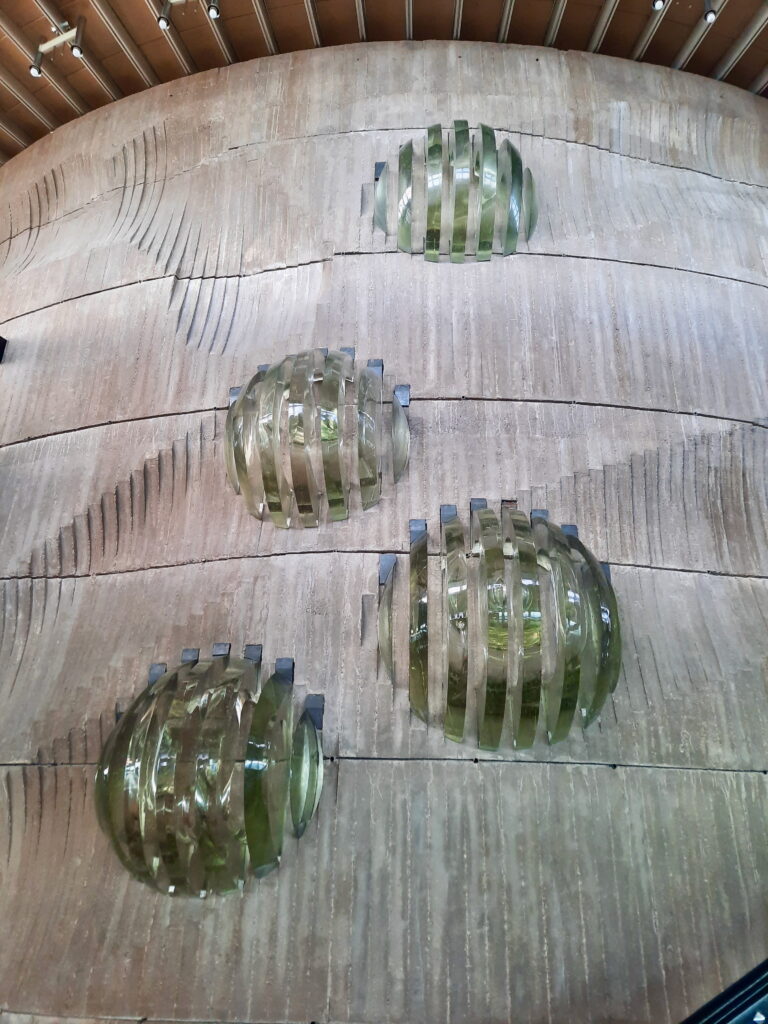
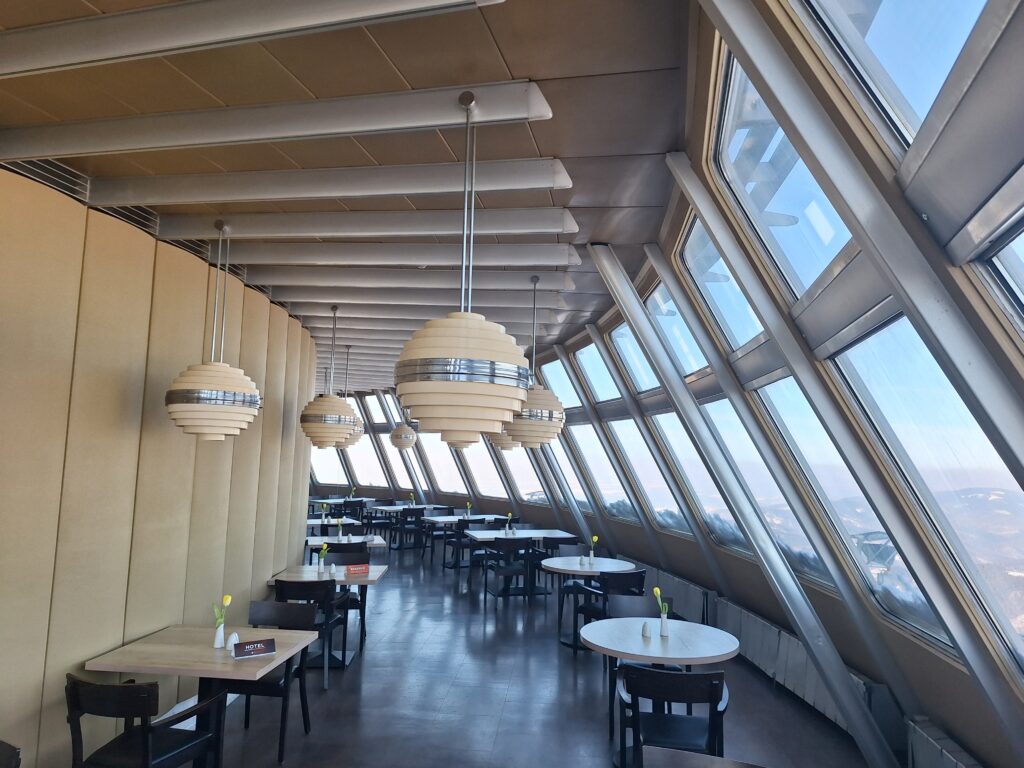
The interiors, including all the furniture, were designed by architect Otakar Binar.
Some of the original works of art have remained until nowadays and one of those is the glass sculpture mounted on the central concrete structure of the building.
This beautiful piece is called the “Fall of Meteorites” and is the work of Stanislav Libenský and Jaroslava Brychtová.
Another original piece that still exists today is the wrought iron-rail in the hotel lobby, which was created by Jaroslav Klápště.
And a last piece is a tapestry by Vladimír Křečan, which is on a wall of the private lounge.
The thus become tradition of climbing Ještěd
I have a sort of tradition of climbing Ještěd both in summer by cycling and in winter by hiking in the snow.
Summer bike ride to the top of Ještěd
There are many social rides and races to reach the top of Ještěd.
The location and the road to it make it one of the most famous rides, especially among roadies, and a very good training.
In the early years of this tradition, I would catch some friends coming from Prague in Mladá Boleslav and we would ride to the mountain’s summit. Afterward, we would take a bus from Liberec back to Prague.
Nowadays, I tend to do a loop from and to Turnov, which is easily reachable by train and by car. If you travel by car, you can park for free at the side of the train station or at the bus station.
My favourite route foresees climbing from the back, coming from Světlá pod Ještědem, and descending from the front.
One of the last rides followed this route.
Winter hike from Liberec to the top of Ještěd
I wait for the snow to cover Ještěd and then I organize a 1-day hike starting from Prague.
Liberec is about 1 hour ride by bus from Prague. The bus leaves from Černý Most and it drops you off at the “Fügnerova” bus station in Liberec.
You can chose between two bus companies to travel: Regiojet (often called with the old name “Student Agency”) or Flixbus.
From the bus station in Liberec, you cross the square to go get tram n.3 until the last stop in Horní Hanychov, which is exactly at the foot of mount Ještěd.
Before embarking on the trip, you can have a pit stop at the “Forum” shopping centre in Fügnerova, where you can use the toilets (paid) and grab a coffee or have breakfast.
When you are in Horní Hanychov, you start walking following the blue marked path to leave the inhabited area.
Once you reach the forest you keep going, you cannot really get lost, as the trail is straight and pretty wide. You will also meet several people walking or running up and down.
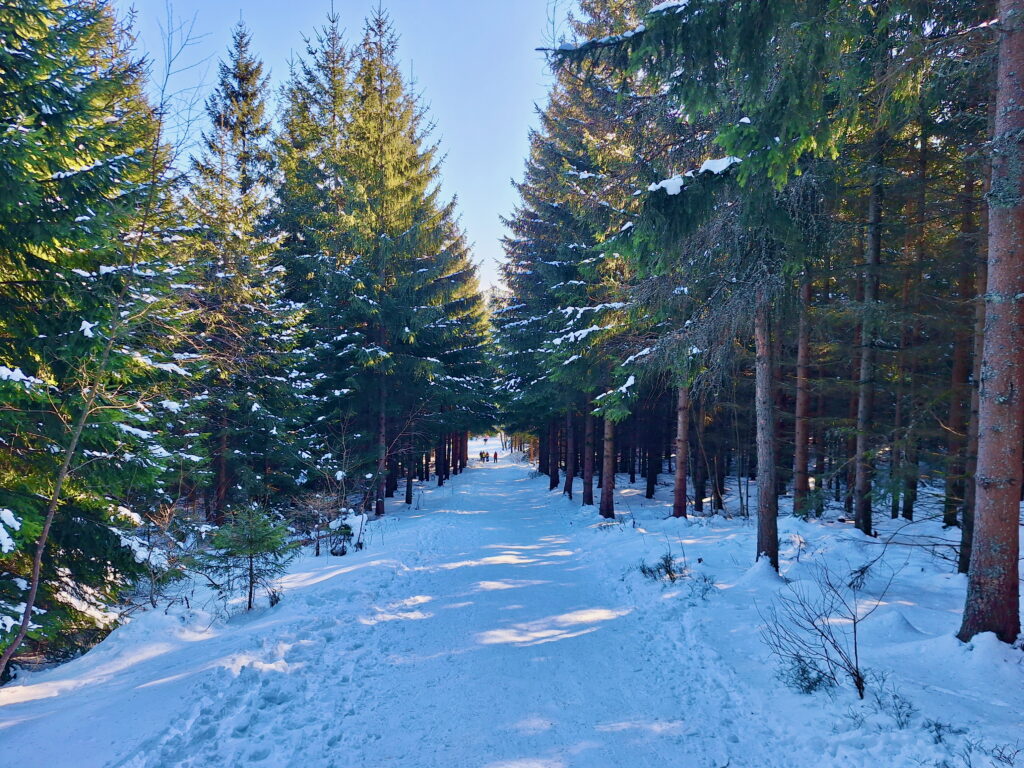
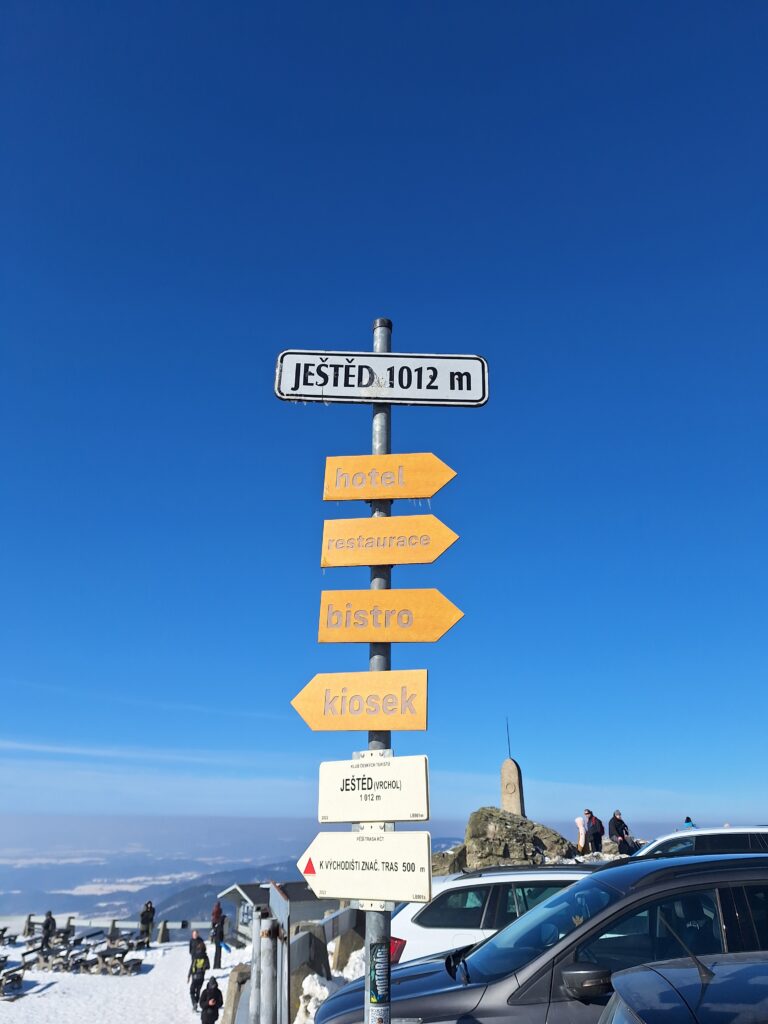
At the crossing in “Nad Výpřeží” you turn left to follow the red trail, which will lead you to the top.
In case you need the map, I leave it here. It is a short, but enjoyable walk.
You can definitely extend it and follow other paths. Just keep to the marks and don’t get lost in the snow.
I would recommend bringing crampons with you, as if the snow is not fresh you will find several sections covered by ice.
What to do at the top?
When you arrive at the top, you can chose what to do, depending on the season and on the weather.
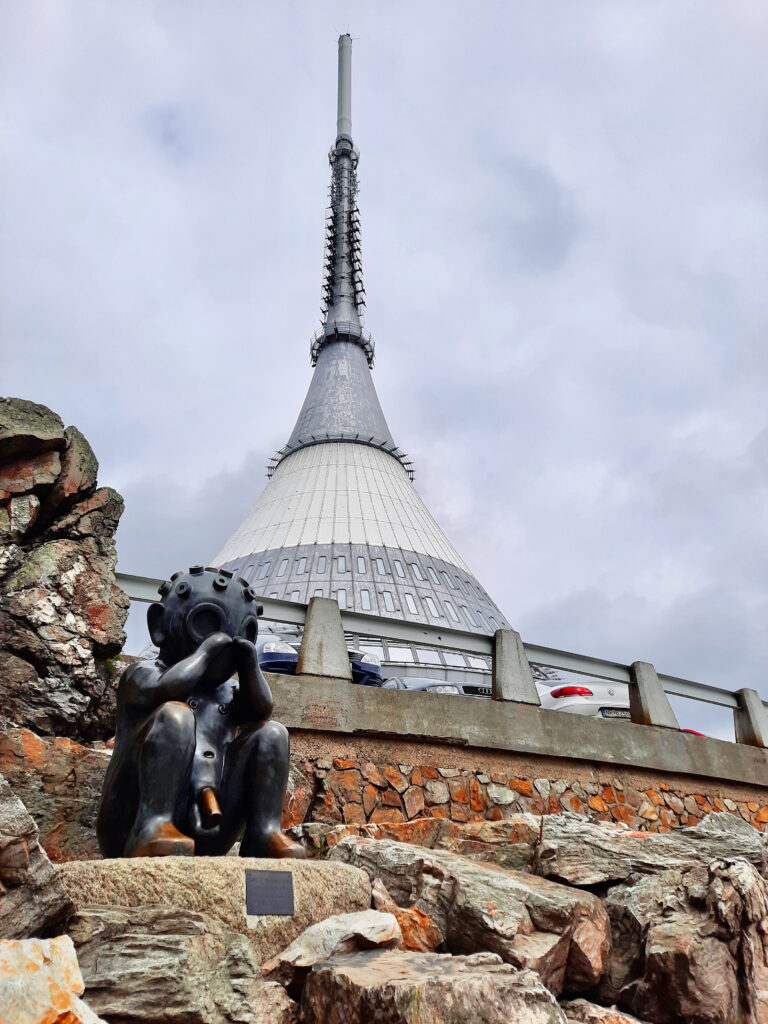
In summer, there is a kiosk installed outside on a pedestrian space, together with some benches.
You can get some snacks there or just rest and enjoy the view and panorama.
In this area you will see the famous sculpture “Child from Mars” from the renowned Czech sculptor Róna.
Otherwise, you can enter the rocket building and either stop at the bistro on the second floor, or walk up the stairs to the restaurant.
Both are open year-round.
I mostly prefer going up to sit at a table close to the windows, and close to the heating in winter.
The bistro is cold, and often noisy and dirty. Nobody takes care to clean the tables and the floor and many people eat their own food there.
At the restaurant the atmosphere is cozier, you can relax, and the choice of food is a bit wider, even though we are always talking of Czech food (Česká klasika), and the prices here are higher.
No matter the season, if there is no killer wind, take a walk around the building and enjoy the view and the experience.
Extras
Until 2021 a cableway was working from Horní Hanychov, when due to an accident and malfunctioning it was decided to stop it.
A project for a new cable car is on the way, but from what I have read it won’t go into operation before 2029.
Even though I believe that the Ještěd experience should be done in a “natural” way, If you don’t want to cycle nor walk, you can reach the top by car and park at one of the several parking areas on the way. Remember that the higher you park, the more you pay.

